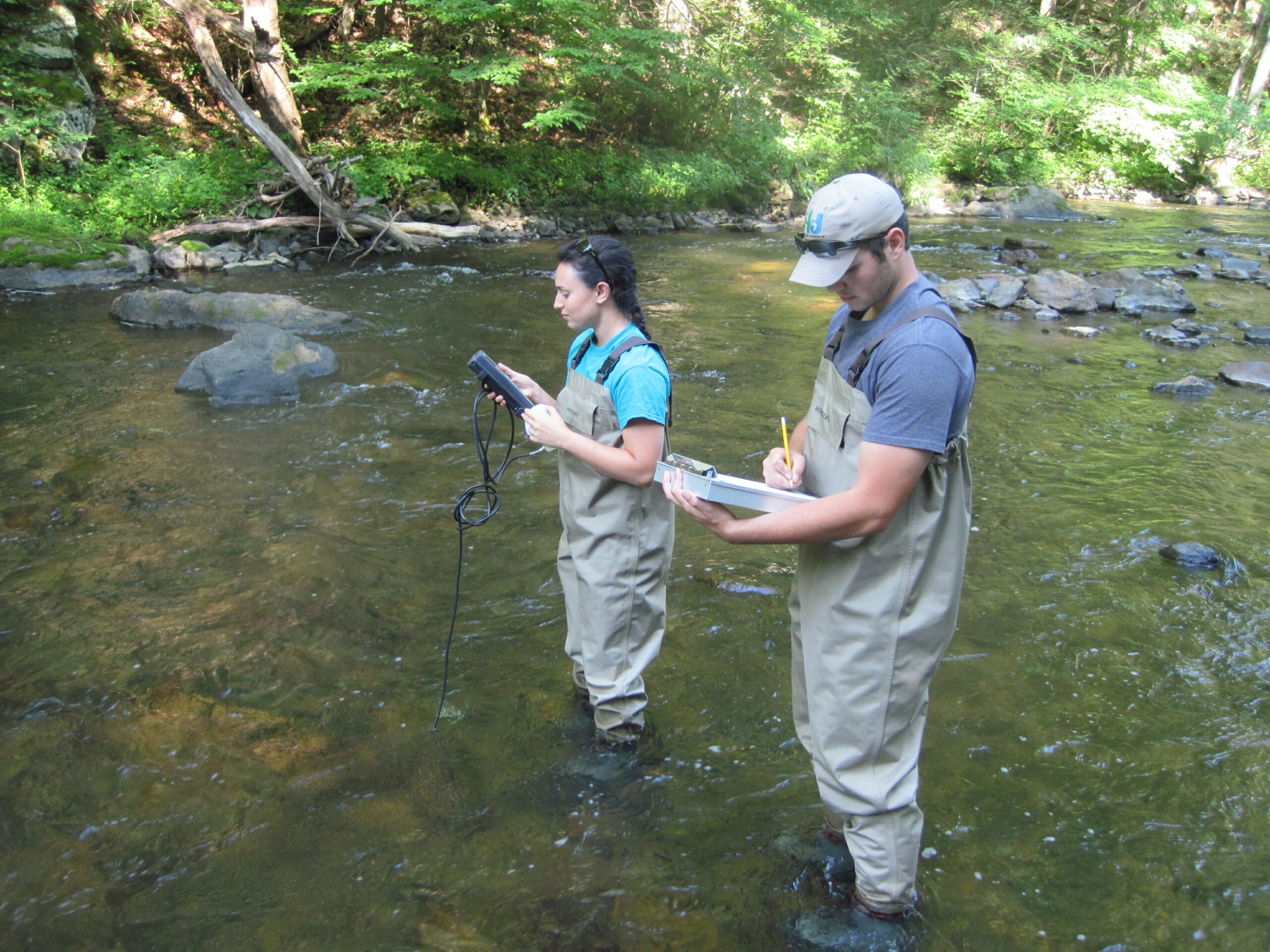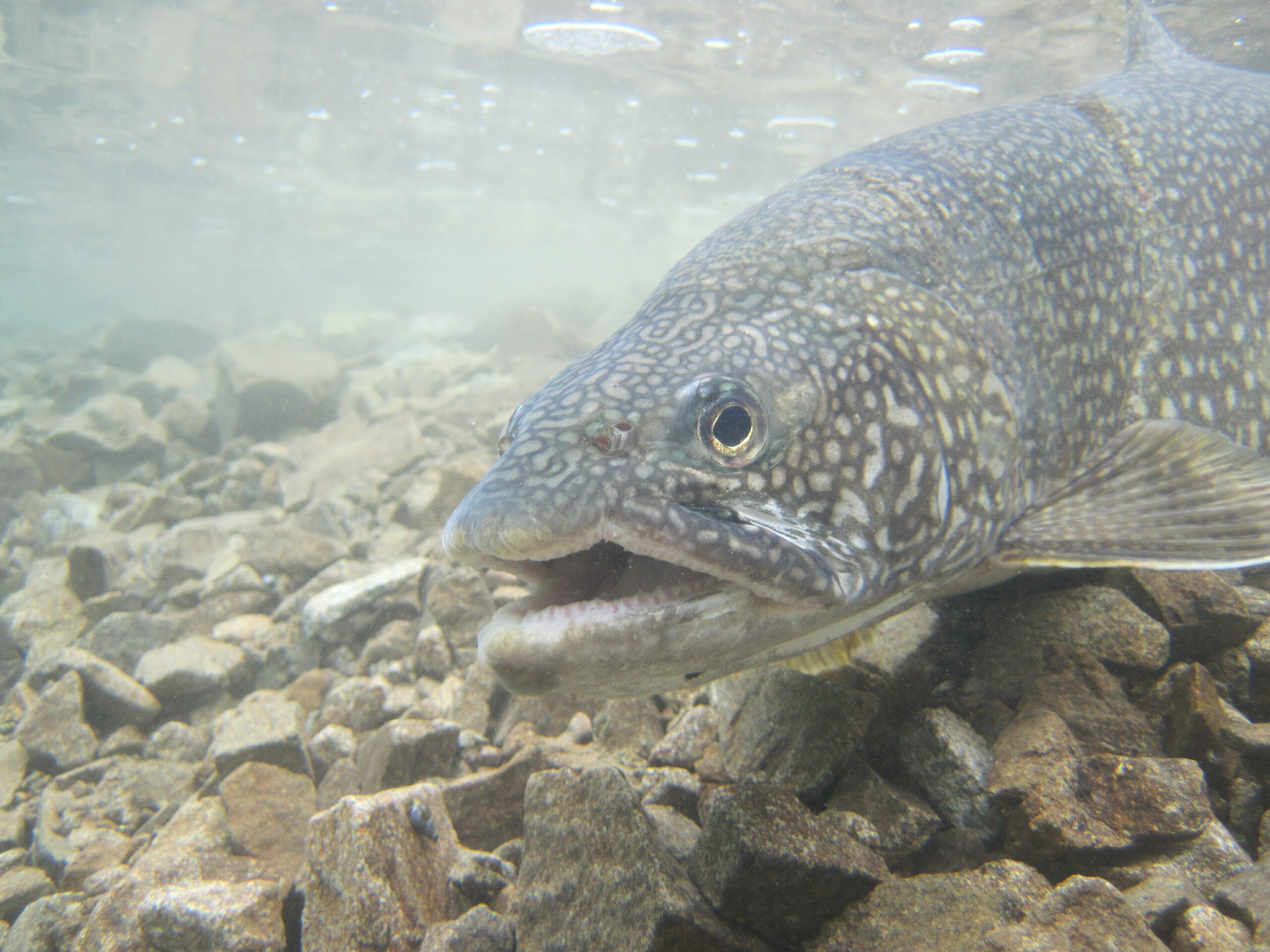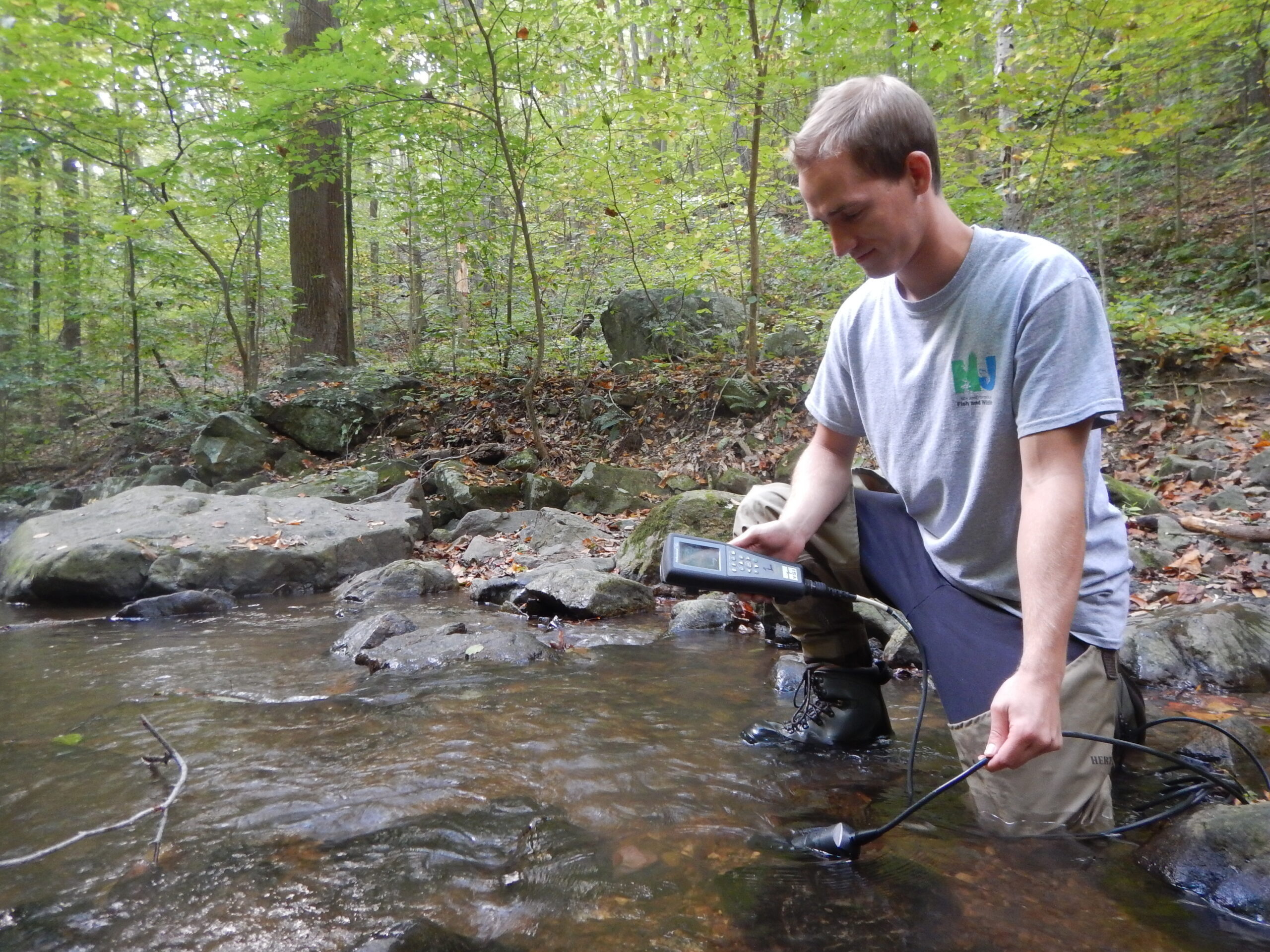
New Jersey contains a diverse array of aquatic habitats, given its relatively small size. These range from cold headwater streams and deep highland lakes found in the northern portion of the state, to shallow coastal plain impoundments, slow moving tidal rivers, and unique tannin-stained waters of the Pinelands found in southern New Jersey. Maintaining quality habitat is key to providing quality recreational angling opportunities, while preserving the numerous unique and diverse fish assemblages found in New Jersey. The future of coldwater fishes in New Jersey, particularly salmonids such as Brook Trout, will depend heavily upon managing their habitat and sustaining the health of ecosystems critical to their survival.
In the face of human activities that continually disrupt the natural processes occurring within watersheds, this will be at times a daunting task for resource managers. Threats to New Jersey’s coldwater resources and the continued survival of trout are warm summer water temperatures and degradation of the physical features of stream channels.
Ensuring New Jersey’s aquatic habitats are properly managed is in the best of interest of everyone. Identifying the threats that negatively impact habitat is the first step in preventing degradation. Quality habitat can be defined as all the necessary components of an aquatic ecosystem that a fish needs to thrive during all stages of its life, such as shelter, forage, water quality, and suitable spawning areas. Availability of quality habitat is often the primary limiting factor for many waters. If one or more component is missing or limited, the fish population and its corresponding recreational fishery will suffer. However, habitat degradation negatively effects much more than just fish populations, as it can lead to impaired water quality, swimming beach closures, and harmful algal blooms to name a few, all of which effectively impact the use of our aquatic resources.
Causes of Aquatic Habitat Degradation
Pollution

Pollution comes in two different forms: point and non-point. The difference between the two is that point source pollution has a single, identifiable source, while non-point spurce pollution is diffuse and hard to distinguish sites throughout a drainage.
Major types of non-point source pollutants can include:
- Soil/Sediments
- Nutrients, often in the form of fertilizers
- Pesticides
- Industrial and household chemicals
Runoff from agricultural areas, lawns, construction sites, golf courses, roads, and other land disturbances are the main ways non-point source pollution enters waterways.
Examples of point source pollution include discharge outlets such as sewage/wastewater treatment plants and thermal effluent outlets from power plants. Point sources are much easier to control when compared to non-point sources.
Urbanization and Land Use Changes
Urbanization is the process of making an area more urban in nature. New Jersey’s extremely dense and ever-growing population has caused the rate of urbanization to increase over the years. Places that were once historically farms or forested lands become converted into housing developments, shopping centers, and other man-made urban features. With such development comes changes that are harmful to fisheries. Urbanization results in the loss of once-suitable habitat and can effectively eliminate high-quality habitat both locally and downstream. The most troubling effect of urbanization with regards to aquatic ecosystems and fisheries is the overall decrease in water quality associated with it. Watersheds associated with urban or developed areas typically have elevated levels of pH, total dissolved solids, increased turbidity, and excessive nutrient loading. Developed shorelines and impervious surfaces, such as rooves and pavement, increase run-off into the water. Increased salinity levels have been observed from road salt entering waters via storm drains and direct run-off. Additionally, bulkheads and manicured lawns eliminate beneficial riparian buffers and allow fertilizers and pesticides to enter the water. Preserving intact watersheds and maintaining beneficial land use practices, while reducing urbanization is key to providing quality fish habitat moving forward.
Due to the rapid pace of land development in New Jersey, perhaps the best way to ensure the long-term survival of coldwater resources is to purchase and set aside for posterity not just coldwater stream corridors and lakes, but adjacent riparian and upland property within the watershed. It is far easier to preserve coldwater resources than to restore them once they have been degraded. Although this may be the most cost-effective approach in the long run, property values in New Jersey continue to rise, and this form of habitat protection becomes increasingly cost prohibitive. An alternative approach may involve the purchase of conservation easements that restrict land development.
Sedimentation

Sediments are fine particles suspended in the water column that originate from erosion within a watershed, including sand, silt, and clay particles. Sedimentation is the process by which sediments are transported via water flow in rivers and streams and ultimately settle and accumulate over time. It should be noted that sedimentation is a natural ongoing process; however excessive sediment deposition can reduce and eliminate quality fish habitat.
The deposition of solids decreases reservoir storage capacity, smothers fish spawning sites, reduces the diversity and abundance of many kinds of aquatic life including prey species, and encourages the establishment of invasive aquatic plants. The loss of water depth associated with sedimentation is a major concern for numerous aging impoundments across the state. Many impoundments have seen substantial sedimentation and the formation of shallow deltas at their headwaters, resulting in large unproductive areas that were previously not present. Reduced water depth in lakes can also decrease recreational angler satisfaction and make such waters more susceptible to winterkill events.
Erosion control measures, such as retaining riparian buffers and other actions that maintain bank stability are key to reducing excessive sedimentation. On old/aging reservoirs, such practices alone may not be enough to combat the effects of sediment deposit over the years. If a lake basin has been made too shallow from sedimentation, mechanical dredging is only method to remove the materials, however this is expensive.
Eutrophication
Eutrophication is the process of excessive nutrient loading in a waterbody, typically associated with elevated levels of Phosphorus and Nitrogen. Phosphorus is a key metabolic nutrient, and the supply of this element often regulates the productivity of natural waters. The consequences of eutrophication are often seen through frequent algal blooms, decreased water transparency, scums and mats of cyanobacteria, and dense littoral zone beds of submergent and emergent vegetation.
Nutrient input is often the result of municipal and industrial wastes/effluents and run off from large residential areas and agricultural activities including barnyards, feedlots, manured/fertilized fields, and row crops. Reducing nutrient input at its source is the most obvious solution, however in most cases this is difficult to determine. Proper monitoring and observation can be key in detecting habitat degradation issues cause by eutrophication. Typically, once the nutrient source has been controlled or eliminated and the existing excessive nutrients consumed, the negative effects of eutrophication may diminish.
Dams

Water impounded by an on-stream dam can eliminate or negatively impact riverine habitat both upstream and downstream of the barrier. Whether built for recreation, water diversion, hydropower, potable water, flood control, or other reasons, manmade dams are responsible for impacting more trout habitat in New Jersey streams than one might initially realize.
- Impounded water is susceptible to excessive warming during the summer, and warm water can cause stressful or lethal water temperatures for coldwater fishes residing in both the impounded area and locations downstream.
- Silt and sediment that collects behind the dam can impact in-stream habitat by smothering spawning sites and crucial habitat for macroinvertebrate species that are important prey items for fishes.
- Downstream flow can be reduced, particularly during the summer and periods of drought.
- Dams are often barriers to fish movement, limiting the amount of available spawning habitat to fish within a particular stretch of a river and impeding further movement upstream.
Typically, the best solution to reverse impacts from man-made dams is to remove the dam itself. However, finding solutions to problems caused by existing manmade ponds, lakes, and reservoirs that currently provide a useful function to their owners and recreational users but also impact coldwater resources, can be more challenging because permanent dam removal is not usually an option. To resolve a problem, it may be necessary to develop a set of practices tailored to each specific situation, that are designed to avoid or minimize aquatic resources impacts. When maintaining minimum flows during the summer, the release of cold water from deeper portions of water column, rather than warmer surface water, is sought in order to maintain coldwater aquatic resources downstream. However, the benefit of a coldwater release may be negated if this water is low in dissolved oxygen, especially when laden with hydrogen sulfide.
Channelization and Stream Cleaning
Channelization is the process of straightening and/or widening a river or stream channel and is occasionally performed as part of stream crossing and road widening projects. Channelization often leads to reduced habitat diversity, as this process often causes the river in the immediately impacted area to become shallower and contain less structure and habitat features that are important for fish habitat.
Municipalities, county Mosquito Commissions, and farmers are probably most active in stream cleaning activities intended to improve runoff patterns. These small-scale projects can cause localized damage by leaving a uniform stream bottom devoid of cover and structure for fish. Beneficial woody debris, that should be left in the stream channel unless causing a significant blockage, may often be removed under the guise of stream cleaning.
Climate Change

Climate change is any significant change in the measures (or indicators) of our climate lasting for an extended period. Earth’s climate is naturally influenced by solar energy and other earth systems, like the atmosphere, oceans and land cover, and natural changes in climate resulting from the interactions between the systems that have happened over time. However, recent changes in the climate, over the last century, are due primarily to “man-made” influences, and it is this most recent “climate change” that is the focus of concerns for the future of the planet.
Key climate indicators include major changes in temperature, precipitation, extreme weather events and sea level rise, that occur over several decades or longer. Observations of these indicators across the United States and the world provide multiple, independent lines of evidence of climate change caused by increasing concentrations of greenhouse gases in the atmosphere. Greenhouse gases absorb energy radiating from the Earth’s surface rather than allowing it to be directly transmitted into space. This traps energy close to the surface of the Earth, acting like a blanket that warms the planet. This phenomenon, known as the greenhouse effect, is natural and necessary to support life on Earth. However, the ever-increasing amounts of greenhouse gases over the past century have increased this warming of the Earth’s climate, resulting in dangerous effects to human health and welfare, and to ecosystems and wildlife as well.
From a freshwater fisheries perspective, the main threat associated with climate change is increased water temperatures. Increased temperatures can cause stress and even be fatal to fish, especially coldwater and coolwater species. Altered rainfall events can change historic flow regimes needed by fish to complete their life cycle. Increased highwater events in rivers outside of typical spring conditions, can lead to increased runoff, turbidity, and loss of vulnerable young of the year fishes.
 Official Site of The State of New Jersey
Official Site of The State of New Jersey
